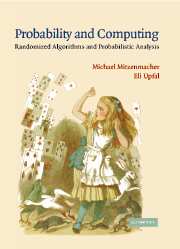Book contents
- Frontmatter
- Contents
- Preface
- 1 Events and Probability
- 2 Discrete Random Variables and Expectation
- 3 Moments and Deviations
- 4 Chernoff Bounds
- 5 Balls, Bins, and Random Graphs
- 6 The Probabilistic Method
- 7 Markov Chains and Random Walks
- 8 Continuous Distributions and the Poisson Process
- 9 Entropy, Randomness, and Information
- 10 The Monte Carlo Method
- 11 Coupling of Markov Chains
- 12 Martingales
- 13 Pairwise Independence and Universal Hash Functions
- 14 Balanced Allocations
- Further Reading
- Index
5 - Balls, Bins, and Random Graphs
- Frontmatter
- Contents
- Preface
- 1 Events and Probability
- 2 Discrete Random Variables and Expectation
- 3 Moments and Deviations
- 4 Chernoff Bounds
- 5 Balls, Bins, and Random Graphs
- 6 The Probabilistic Method
- 7 Markov Chains and Random Walks
- 8 Continuous Distributions and the Poisson Process
- 9 Entropy, Randomness, and Information
- 10 The Monte Carlo Method
- 11 Coupling of Markov Chains
- 12 Martingales
- 13 Pairwise Independence and Universal Hash Functions
- 14 Balanced Allocations
- Further Reading
- Index
Summary
In this chapter, we focus on one of the most basic of random processes: m balls are thrown randomly into n bins, each ball landing in a bin chosen independently and uniformly at random. We use the techniques we have developed previously to analyze this process and develop a new approach based on what is known as the Poisson approximation. We demonstrate several applications of this model, including a more sophisticated analysis of the coupon collector's problem and an analysis of the Bloom filter data structure. After introducing a closely related model of random graphs, we show an efficient algorithm for finding a Hamiltonian cycle on a random graph with sufficiently many edges. Even though finding a Hamiltonian cycle is NP-hard in general, our result shows that, for a randomly chosen graph, the problem is solvable in polynomial time with high probability.
Example: The Birthday Paradox
Sitting in lecture, you notice that there are 30 people in the room. Is it more likely that some two people in the room share the same birthday or that no two people in the room share the same birthday?
We can model this problem by assuming that the birthday of each person is a random day from a 365-day year, chosen independently and uniformly at random for each person. This is obviously a simplification; for example, we assume that a person's birthday is equally likely to be any day of the year, we avoid the issue of leap years, and we ignore the possibility of twins! As a model, however, it has the virtue of being easy to understand and analyze.
- Type
- Chapter
- Information
- Probability and ComputingRandomized Algorithms and Probabilistic Analysis, pp. 90 - 125Publisher: Cambridge University PressPrint publication year: 2005

